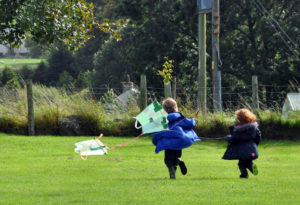Not that sort of wind!
It is universally accepted that it is unsafe to take groups into the woods in high wind. This leads to one of the most asked questions for people who take groups into woodlands. How high a windspeed is too dangerous to be in the woods?
As with any question of risk there is not a simple answer. Having spoken to insurance companies about this the response was to follow your risk assessment and use common sense. This doesn’t mean choosing an arbitrary number because someone has that as their cut off point.
This begs the question what should be in the risk assessment and what should we consider?
The Beaufort scale for land is a really useful starting point for judging when you need to start managing the risk. Here’s a woodland version which should give you a good sense of what will be going on at various predicted wind speeds. Download a copy here.
Remember the predicted windspeed and the actual windspeed could be higher or lower. Look at predicted gusts too. Gusts of 50mph will bring down branches as surely as steady winds of the same speed.
The Met Office have an alert system for the UK which can send you weather warnings for specific locations or regions.
To understand the risk you will also need to consider the geography and state of the woodland. Here are some factors to think about when deciding what windspeed can be tolerated in your wood and if you have to cancel or move site:
- Age of trees, young trees are likely to be more resilient to the effect of wind.
- Health of trees including the amount of deadwood in the canopy. Look for fungi or damage. Even if the fungi is close to or at the base of a beech or other tree it could indicate root plate damage.
- Species of tree; Is it for example crack willow or aspen which are particularly brittle?
- Shape of the trees; as a general rule the more branches there are on a tree the better the wind is diffused throughout it to keep it upright. Are the trees top heavy? Are there ‘wolf’ trees that extend above the rest of the canopy? Are there lots of horizontal branches which sway more in winds?
- Woodland management; have trees been removed that may have protected existing trees from wind? Trees acclimate themselves to what they have experienced.
- Underlying ground conditions; are they wet which could make trees less stable? is the ground rocky or has thin soil which may create shallow root systems?
- Direction of the wind; are you protected by hills or exposed to the elements?
- Direction of the wind; is it different from the usual South Westerly winds we get in the UK? Trees will be more capable of bearing up in these conditions.
- Season; are the trees covered in leaves creating a sail effect? Is this the first storm of the season?
- Proximity of other areas that would be safe e.g. playing fields, meadows or beaches.
- Size of the group and age of the children, could you move quickly if conditions changed?
- Access in and out of the woodland including travel and transport.
- Other weather conditions that might increase the risks. Wind chill can make a cold day feel colder and high winds mixed with snow and ice can be challenging.
Having a plan B up your sleeve is important if you do go ahead. I love making kites, wind socks and streamers when I have to move out of the woods because of wind. I also love leaning against the wind with my coat above my head.
Checking the site after a storm event is important to make sure there is no new hanging dead wood up with the trees.
If it feels unsafe when you are in the woods, then trust your instinct. If you do have to cancel or there are high winds predicted and you can safely get to your site then this would be a good opportunity to assess how the wood responds to different wind speeds. You can get Anemometers to help you measure actual wind speed compared with predicted winds in your location.
I probably wouldn’t go as far as that great American naturalist John Muir and climb to the top of a big tree in a wind storm to truly experience the power of nature. His essay ‘A wind storm in the Forests’ is an amazing piece of writing.












